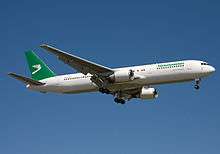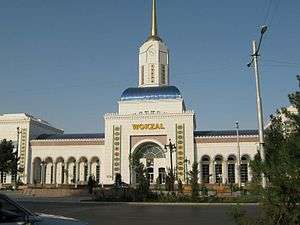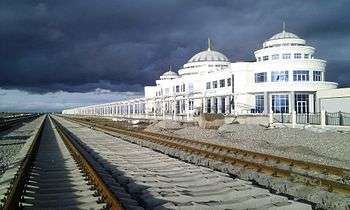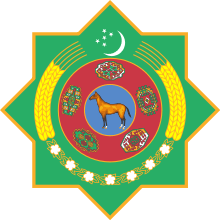Transport in Turkmenistan
Transport in Turkmenistan includes such as roadways, railways, airways, seaways, waterways, oil, gas and water pipelines.
The transportation and transport infrastructure in Turkmenistan are the fasted developing sectors of the national economy.[1]
During Soviet times Turkmenistan's transportation infrastructure was in general disrepair and neglected.
Since 1991 Turkmenistan has completed a number of major national and international transportation projects.
Turkmenistan is also part of the international transport corridor created under the Ashgabat agreement, signed by India, Oman, Iran, Turkmenistan, Uzbekistan and Kazakhstan, for creating an international transport and transit corridor facilitating transportation of goods between Central Asia and the Persian Gulf.[2]
Airways

In 2014, Turkmenistan had an estimated 26 airports.[3] One heliport was in operation.
There are three international airports in the country. One is under construction.
- Oguz Han International Airport is under construction. When completed in 2016 it will be the biggest airport in Central Asia and will also be worth $2.2bln.[4]
- Ashgabat International Airport was enlarged and modernized in 1994.[4]
- Turkmenbashi International Airport was constructed in 2010.[4]
- Mary International Airport was upgraded in 2009.[4]
Other main provincial airports are Dashoguz Airport, Balkanabat Airport and Türkmenabat Airport. Flights are available from Ashgabat and Turkmenbashi to over 21 international destinations in United Kingdom, France, Germany, Turkey, Russia, China, India, Ukraine, Kazakhstan, Thailand, United Arab Emirates and Uzbekistan.
Turkmenistan Airlines (Türkmenhowaýollary) is the flag carrier airline of Turkmenistan, headquartered in Ashgabat.[5] The airline connects its home base of Ashgabat with destinations in Russia, Europe and Asia. All its international flights are operated by Western-trained pilots using two-class configuration Boeing aircraft. In 2012, the airline carried 57.5 thousand passengers to 15 international destinations and 90 thousand passengers on domestic routes per month. This translates into 1.77 million passengers per year. [6]
Railways


In 2014 Turkmenistan had 4,980 km (3,094 mi) of rail line, most of which runs close to the northern and southern borders. The Tejen – Serakhs – Mashhad railway, built in 1996 by Turkmenistan and Iran, has become a vital link of Central Asian, Russian, and European rail systems with South Asia and the Persian Gulf. In February 2006, the final construction phase began on the Trans-Karakum Railway, a direct link between Ashgabat and Dashoguz that will halve travel time between the southern and northern borders. Urban transportation systems are being upgraded in Ashgabat, Dashoguz, and Mary.
The Kazakhstan - Turkmenistan - Iran railway link is a part of the North–South Transport Corridor and is a 677 km (421 mi) long railway line connecting Kazakhstan and Turkmenistan with Iran and the Persian Gulf. It links Uzen in Kazakhstan with Bereket - Etrek in Turkmenistan and end at Gorgan in Iran's Golestan province. In Iran, the railway will be linked to national network making its way to the ports of the Persian Gulf.[7] The project is estimated to cost $620m which is being jointly funded by the governments of Kazakhstan, Turkmenistan and Iran.[7][8]
The project also aims to create a multi-modal transport system to provide seamless connectivity in the region for passenger travel as well. The link of the North-South Transnational Railway will run up to 137 km in Kazakhstan, 470 km in Turkmenistan and 70 km in Iran.
Work in Turkmenistan commenced in Bereket in December 2007 and in Kazakhstan in July 2009.
In May 2013, a 311 km (193 mi) Bereket – Uzen section of the 677 km (421 mi) North-South Transnational Railway was completed.[9][10] In February 2014 256 km (159 mi) long section between Bereket and Etrek was completed. Currently railway stations along the new railway are being constructed.[11]
The Kazakhstan - Turkmenistan - Iran railway link will be officially inaugurated in October 2014.[12]
Railway links with adjacent countries
- Iran - yes, cargo only - 1,520 mm (4 ft 11 27⁄32 in)/1,435 mm (4 ft 8 1⁄2 in) break-of-gauge
- Afghanistan - yes - very short to Towraghondi, no passenger service
- Kazakhstan - new rail link opened in 2013.
- Uzbekistan - yes, service halted indefinitely
- Caspian Sea - irregular ferry, passenger only.
Roadways
In 2001 Turkmenistan had an estimated 22,000 kilometers of roads, about 18,000 kilometers of which were paved. One major highway runs westward from Mary, along the Iranian border through Ashgabat and then to Turkmenbashi on the Caspian Sea; a second runs northwestward from the Afghanistan border through Turkmenabat, along the Uzbekistan border to Dashoguz. In the early 2000s, major road-building projects improved sections of the highway connecting Ashgabat with Balkanabat, Bereket, Turkmenbashi and Mary.
Turkmenistan has one of the lowest gas prices in the world, at $0.72 per gallon ($0.19 per liter).[13]
Seaways
Riverways
The main inland waterways are the Amu Darya River, which runs along the northern border, and the Karakum Canal, which runs from east to west from the Amu Darya near the Afghanistan border through Mary and Ashgabat to Turkmenbashi on the Caspian coast. The 1,400-kilometer canal, designed mainly for irrigation, is navigable for 450 kilometers from its Caspian terminus. Because water is withdrawn for irrigation, the Amu Darya is navigable only about 250 kilometers downstream from the Afghanistan border to Turkmenabat.
The official beginning of the organized navigation on the Amu Darya is 1873.[14] In 1890, based on the Amu Darya military dam. In 1917 there were on the Amu Darya 20 and 50 self-propelled vessels and about 1500 boats. In 1923 was created the Central Asian Turkmenabat Shipping. Shipping Company provided services to Turkmenistan, Uzbekistan, Tajikistan and 10 regions of Kazakhstan, and transported by water loads on 1.5 thousand kilometers. August 15, 1992 Turkmen River Shipping company was established. In 2003, it was renamed into State Company Turkmen Riverways (Türkmenderýaýollary).
Derýaýollary within the territory of Turkmenistan serves the navigable part of the Amu Darya length of 813 kilometers, and the Karakum Canal length of 200 kilometers. Combining a universal and specialized vessels capable of carrying a variety of cargo and passengers.
Pipelines
Major ports and harbours
The main port at Turkmenbashi on the Caspian Sea is being renovated. Main shipping lines cross the Caspian to Astrakhan in Russia and Baku in Azerbaijan. Smaller Caspian ports are Alaja, Hazar, and Ekerem. Plans call for expansion of Ekerem into a second major Caspian port. In 2006 Turkmenistan had eight merchant marine vessels of more than 1,000 tons displacement, of which four were cargo ships, two were oil tankers, one was for refrigerated cargo, and one was a combination ore and oil ship.
See also
References
- ↑ "Railways in Turkmenistan". Ministry of Railways of Turkmenistan. Retrieved 2014-03-26.
- ↑ The Hans India - India accedes to Ashgabat agreement
- ↑ https://www.cia.gov/library/publications/the-world-factbook/geos/tx.html
- 1 2 3 4 "Turkmenistan builds international airports". centralasiaonline.com. 2013-03-06. Retrieved 2014-02-27.
- ↑ "Directory: World Airlines." Flight International. 30 March-5 April 2004. .
- ↑ http://www.turkmenistan.ru/en/articles/16824.html
- 1 2 "North-South Transnational Corridor". railway-technology.com. Retrieved 2014-03-25.
- ↑ "Crossing of Railways". turkmenistaninfo.ru. Retrieved 2014-03-25.
- ↑ "Presidents open Kazakhstan to Turkmenistan rail link". Railway Gazette International. Retrieved 20 May 2013.
- ↑ "Caspian rail corridor funds agreed". Railwaygazette.com. Retrieved 2010-02-23.
- ↑ "Завершено строительство участка Берекет - Этрек магистрали Казахстан–Туркменистан–Иран". Turkmen Business. Retrieved 2014-03-10.
- ↑ "Iran-Turkmenistan-Kazakhstan railway to come on stream in 6 months". Zawya.com. Retrieved 2014-03-25.
- ↑ http://www.csmonitor.com/World/Americas/2011/0913/World-s-cheapest-gas-Top-5-countries/Turkmenistan-0.72-per-gallon-0.19-per-liter
- ↑ "River ways in Turkmenistan". turkmenmaritime.gov.tm. Retrieved 2014-03-27.
![]() This article incorporates public domain material from websites or documents of the Library of Congress.
This article incorporates public domain material from websites or documents of the Library of Congress.

